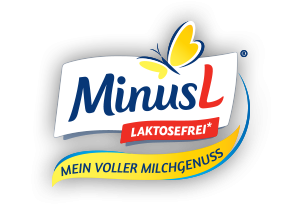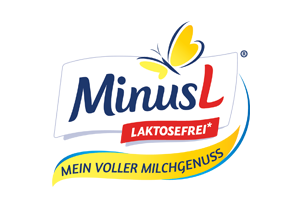
FAQs
Here you can find the answers to the most frequently asked questions revolving around lactose intolerance and MinusL products.
GENERAL QUESTIONS
No. Lactose is used in many foods & beverages due to its technological attributes. For example, bread, sausage products, spice blends, crisps, crackers and the like can contain lactose, too.
No. The milk from nearly all mammals contains lactose, so the same applies to sheep’s and goat’s milk. Sheep’s milk contains approx. 4.8 g lactose / 100 g, and goat’s milk an average of approx. 4.1 g / 100 g.
The individual lactose tolerance is the amount of lactose that can be tolerated before a person begins to experience symptoms of discomfort. This limit is very different from person to person. People with a lactose intolerance have to find out just how much lactose they are able to tolerate.
It might be that what you have is not a lactose intolerance but a milk protein allergy. Consult your physician about the kinds of symptoms you have observed.
QUESTIONS ABOUT LACTOSE INTOLERANCE
Lactose intolerance numbers among the so-called intolerances to foodstuffs. In short: a person is no longer able to tolerate the milk sugar called lactose. The reason for this is an insufficient production of lactase, the enzyme necessary for digestion.
Lactose is another name for milk sugar. It occurs naturally in milk and in all foods & beverages made with milk. Lactose is a so-called disaccharide, which means it is comprised of two simple sugars called monosaccharides. These monosaccharides deal with glucose and galactose. Lactose = glucose + galactose.
Lactase is a so-called digestive enzyme. It is produced in the small intestine and mandatory for the digestion of lactose. This lactase breaks lactose down in the small intesine into its two components, glucose and galactose.
Lactose intolerance can be found all over the world. Around 75% of the global population is affected by it. In Germany, around 15 to 20% of the population is no longer able to tolerate any milk.
A lactose intolerance can occur due to a genetic predisposition or due to damage to the mucous membrane lining the small intestine.
No. Lactose intolerance is not an allergy. It is an incompatibility with certain foods & beverages.
It depends on the type of lactose intolerance. The primary type is congenital, i.e. people are born with it and the intolerance stays with them for their whole life. The secondary type can go away by itself or at least get better.
QUESTIONS ABOUT MinusL PRODUCTS
No. All lactose-free products have been developed specifically for people with a lactose intolerance. Only one factor makes them different from conventional dairy products: lactose, the carbohydrate contained in normal dairy products, is not present as a disaccharide sugar. The products contain glucose and galactose, the simple sugars that occur when lactose is broken down. All other nutrients – including milk protein – are retained unchanged.
No. Since the lactose is not removed from the milk and is instead broken down into its two constituent monosaccharide simple sugars, glucose and galactose, the milk still contains them. That’s why MinusL milk has the same galactose content as conventional milk.
MinusL products are available at food retailers and at selected drugstore chains. In addition, a variety of online shops offer a selection of MinusL products for sale.
Yes. You can use all MinusL products for cooking and baking exactly the same way you use conventional dairy products.
To a certain degree. Our unsweetened MinusL products such as milk, natural yoghurt, cheese etc. are fructose-free, and can therefore be enjoyed with no problems. In the case of sweetened MinusL products such as fruit yoghurt, pudding and chocolate milk, they contain different amounts of fructose. With these MinusL products the tolerable amount must be tested individually.
No. In the course of production the lactose is broken down into its two components, glucose and galactose, with the help of an enzyme called lactase. That’s how MinusL products are made tolerable for people with lactose intolerance.
In Germany, all products displaying a lactose content of < 0.1 g / 100 g are allowed to be labelled lactose-free.
MinusL milk tastes a bit sweeter in comparison to conventional milk. The reason for this lies in the production process. The breaking-down of lactose via an enzyme results in glucose and galactose, which display more sweetness than lactose in an undivided state. This means that our senses simply perceive glucose and galactose as being sweeter when compared with lactose. But no sugar is added to MinusL milk! It has the same nutritional values and nutrient content as conventional milk.
To be sure that lactose-free whipping cream always becomes nice and stiff, please keep the cream refrigerated before it is whipped! The same goes for long-life cream, too! What’s more, ideally a chilled bowl and a chilled whisk are used for beating the cream – then nothing can go wrong and enjoyment is as good as guaranteed!
QUESTIONS ABOUT DIAGNOSTIC METHODS REGARDING LACTOSE INTOLERANCE
Consult your family doctor. Frequently this general practitioner is equally able to carry out a test for lactose intolerance. If not, your doctor refers you to a specialist.
There are various possibilities for determining lactose intolerance. If you suspect that you suffer from lactose intolerance, by all means make your doctor aware of this. The so-called hydrogen breath test is regarded as the “gold standard” in the medical field. But a blood test or a genetic test can be carried out, too.




